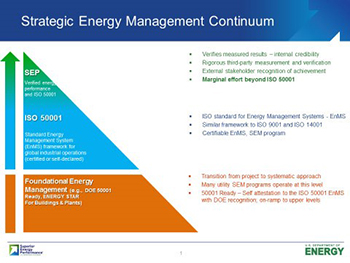Director’s Note
The Forum is pleased to deliver the results of a variety of research efforts summarized in this newsletter and available on the NEEP website. These include: completion of Version 7.0 of the Mid-Atlantic TRM, several cost-effectiveness projects, an update on the M&V2.0 pilot, a blog about carbon reduction impacts from energy efficiency based on REED data, and a white paper on Strategic Energy Management evaluation and cost-effectiveness issues. We were pleased to see those of you who joined in the lively exchanges during our spring conference in Washington DC on EM&V at the Intersection of Policy and Technology and a summer workshop on Cost-Effectiveness for Next Generation Energy Efficiency. For those who missed them, presentations are on the events page of the NEEP website.
Here is a quick shout out on other EM&V accomplishments of note this quarter:
- NEEP released guidance on Claiming Savings from Smart Thermostats in April.
- The National Standard Practice Manual (guidance on cost-effectiveness) was released in May.
- The Uniform Methods Protocol on Strategic Energy Management was released in June.
This summer our webinars include: July 13 – AESP Brownbag on Cost-Effectiveness, a July 27 DOE Webinar on Residential Retrofit Evaluation and July 31 - Non-Intrusive Load Monitoring (NILM): Opportunities, Advances and Challenges.
Or see us on the road (at the IEPEC evaluation conference in Baltimore in August or in Toronto, Canada for the summer AESP meeting). For more information about EM&V Forum topics and events, please contact Elizabeth Titus, etitus@neep.org and PLEASE take three minutes to respond to our M&V 2.0 Survey – so we can share results next quarter.
Cost-effectiveness of Investment in AMI
 NEEP’s first joint venture with GreenTech Media Research was a webinar on the cost-effectiveness of advanced metering infrastructure (AMI) and forward-looking deployment levels in the Northeast and beyond. GTM analyzed AMI project progression, as well as AMI projections for the U.S. and globally for 2021. This map by GTM shows AMI penetration levels as of 2015.
NEEP’s first joint venture with GreenTech Media Research was a webinar on the cost-effectiveness of advanced metering infrastructure (AMI) and forward-looking deployment levels in the Northeast and beyond. GTM analyzed AMI project progression, as well as AMI projections for the U.S. and globally for 2021. This map by GTM shows AMI penetration levels as of 2015.
NEEP presented its report on utility trends and AMI cost-benefit analyses in the webinar and in a regional workshop. The report seeks to provide insight into why the Northeast has lower penetration of AMI than other regions. The major question facing public utility commissions is whether the upfront cost of AMI is justified by the benefits of deployment. There is rarely a straightforward answer to this question due to the different types of metering systems and functionality, as well as program specific drivers. The table below shows the variation in just a few types of benefits and costs that were included in utility evaluations.

Non-energy Impacts of Energy Efficiency in the Northeast and Beyond
At the request of stakeholders in New Hampshire, NEEP recently completed a report on non-energy impacts (NEIs) in cost-effectiveness testing based on a review of literature, technical reference manuals, and utility annual reports. The purpose of the report is to objectively document treatment of non-energy impacts in various jurisdictions, with a focus on distinguishing approaches used to develop the impacts (e.g. evidence-based versus other approaches). This provides New Hampshire a foundation it can use to formulate its own recommendations on how to proceed with NEIs. In addition, the report includes key elements in cost-effectiveness guidance and abstracts of selected studies identified from a literature review.

Looking ahead, the region and the country would also benefit from: development of a national central collection place for methods for and values of NEIs; inclusion of NEIs values and formulas in TRMs, protocols or templates to increase transparency; and guidance on implementing cost-effectiveness frameworks.
M&V 2.0 Project kicked off; webinars and workshops being planned
EM&V of Strategic Energy Management (SEM): NEEP White Paper
NEEP released a white paper which provides an overview of the evaluation measurement and verification (EM&V) activities, tools and resources, and challenges associated with SEM, which is a nascent but rapidly evolving program design that can capture continuous improvement associated with the “orb” (operations, retrocommissioning and behavioral changes) of hard-to-measure impacts.
The paper identifies protocols and guidance that can help standardize the process of quantifying impacts. These include ISO 50001 and the Uniform Methods Protocols. Also the paper notes that the National Standard Practice Manual guidance on Cost-effectiveness is relevant to SEM, because these programs include many hard-to-quantify non-energy impacts that are overlooked in most cost-effectiveness analysis.
After summarizing results reported by various programs, the paper identifies areas where even more guidance could help the industry advance this program design. These include: interactive effects between OMB and capital investment programs; treatment of baselines and persistence when disaggregating OMB from capital investment savings; assessing impacts from the implementation of multiyear programs; and quantifying significant non-energy benefits.

The SEM program design is compelling, but with more program experience, evaluations will be better equipped to document results and convey the full value of the program. Work is needed to refine approaches to improve accuracy in measurement and the ability to measure diverse program applications. Strategies that reduce evaluation costs – such as scaling up, homogenous cohorts, use of energy management information systems (EMIS), improved tracking – are now being explored.
Forum Updates
Recap of NEEP EM&V Spring Conference (all slides available online)
There was lively exchange between regulators, evaluators, smart thermostat vendors, advocates, and DOE and EPA staff on forward-looking topics. The day began with cost-effectiveness for the next generation and showcased Rhode Island’s innovative Docket 4600 which is applying the guidance of the new National Standard Practice Manual in an integrated DSM context. A panel on whole-building research included discussion of how VEIC is repurposing smart thermostat data to be an M&V2.0 resource, as well as panelists who represented perspectives that are represented in a recent RMI white paper on the promise and challenges of M&V2.0 (read more about this in a recent blog). Smart thermostats reappeared in panel delivered as a play in three Acts: Act 1 being overview of current evaluation results, Act 2 being vendor research, Act 3 being EPA resources, and concluding with a discussion of NEEP’s Guidance on Claiming Savings from Smart Thermostat. The day wrapped up with the program administrator experiences with the promise and challenges of midstream programs, motivation for some evaluation guidance being prepared for the EPA Retail Products Platform where the focus of evaluation needs to be midstream and long term yet also satisfy traditional regulatory needs. Read more about the event here.
Mid-Atlantic TRM Version 7 Completed! Version 7.5 starting soon
You can download Version 7 here. D.C. funding now available for completion of more of the scope that was planned for 2017.
Attention TRM Developers: Tech to Utilities Pipeline Project to make DOE data on emerging technologies more available to program administrators for use in savings estimates.
The Tech to Utilities Pipeline Project is a DOE-funded project which aims to create a framework for utilities to leverage federal agency technology demonstration data to streamline their energy efficiency program measure development. The project will develop a clear pathway for integrating energy technology data from DOE sources into program measures to support the development of transparent, traceable, and accurate savings claims. The initiative offers utilities and other energy program administrators the opportunity to participate in the collaborative process of developing the framework and piloting it on new measures to ensure it meets their needs. NEEP plans to participate in this effort and keep regional stakeholders informed, but for more details, contact Greg Barker at gbarker@energy-solution.com
Regional Energy Efficiency Database (REED)
This quarter, NEEP examined the carbon impacts of energy efficiency programs, as summarized in the REED Rendering brief and blog. Carbon impacts are especially important to states in this region, since several states claim environmental (emissions reduction) impacts as part of cost-effectiveness testing and many states have policies in support of clean energy.
Uniform Methods Protocol on Strategic Energy Management Released in JunE
Read the report here.
Other Uniform Methods Protocol Updates are being developed
This quarter, the steering committee reviewed draft revisions to the following protocols:
- Peak Demand and Time Differentiated Savings
- Residential Lighting
- Small HVAC
- Refrigerator Recycling
- Compressed Air
- Whole Building M&V
- C&I Lighting
- Net to Gross Impacts
M&V2.0 White Paper Released by LBNL and RMI
The Status and Promise of Advanced M&V is a concise overview of the types of opportunities that advanced M&V offers for energy efficiency program design, delivery and evaluation, some of the regulatory and other challenges as well as research and policy needs to help realize the opportunities. The paper was coauthored by a team of highly informed authors from various perspectives including software vendor, government, academia and evaluation consultants.
Mark Your Calendar
Upcoming Forum and other NEEP webinars and meetings of potential interest
- AESP Brown Bag Webinar (July 13): Shifting Our Cost-Effectiveness Perspectives. Register at: http://www.aesp.org/events/EventDetails.aspx?id=981756
- DOE Better Buildings Residential Network Webinar: Peer Exchange on residential energy efficiency programs - Making Program Evaluation Work for You. (July 27, 1:00-2:30 PM ET), https://attendee.gotowebinar.com/register/5283507796524521986
- NEEP Webinar (July 31, 12:30-2pm): Non-intrusive Load Monitoring: Advances and Opportunities. Register at: https://attendee.gotowebinar.com/register/4639626092058545666
- ACEEE Industrial Energy Efficiency Conference: August 15-18 (Colorado).
- IEPEC Conference: August 8-10, 2017 (Baltimore).
- AESP Summer Conference: August 30-31 (Toronto, Canada)
